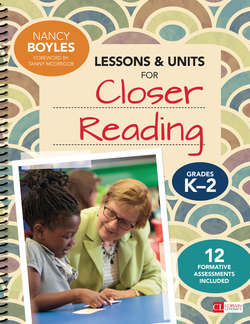Читать книгу Lessons and Units for Closer Reading, Grades K-2 - Nancy Boyles - Страница 68
На сайте Литреса книга снята с продажи.
How to Use the Active Reader Cards
Оглавление1 Copy and cut apart the Active Reader Cards: Identifying Central Ideas and Details. For easier distribution, I place all the Central Idea cards in one envelope and the Detail cards in a different envelope. (For your convenience, you can access these cards on the companion website in a larger format.)
2 If this is the first time you are using these cards, explain the meaning of central idea and detail, and create the chart for Other Words for Central Idea as described earlier. Give a couple of examples of central ideas and the details that would support them. For example, in Goldilocks and the Three Bears, a central idea might be that you should respect other people’s property. Details might be that Goldilocks destroyed Little Bear’s chair and ate his porridge. If you have taught this skill before, review the meaning of each of these terms and ask students for an example or two of a central idea and a detail.
3 Most of the time with primary students, you will be identifying the central idea for them or determining it together.
4 As you reread the text for your lesson on Day 3 or 4, model this skill by looking for a supporting detail or two early in the book.
5 Now provide pairs or small groups of students with two Detail cards and ask them to identify additional details that support this same central idea. (Having multiple copies of your text will aid this process.)
6 Invite students to share their details at the end of the session.
7 You can differentiate this lesson by asking for different numbers of details, asking students to identify the central idea as well as the details, or asking students to determine details for a different central idea than the one you have modeled.
